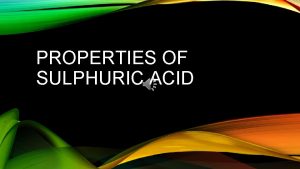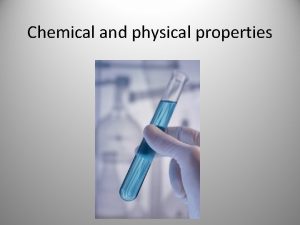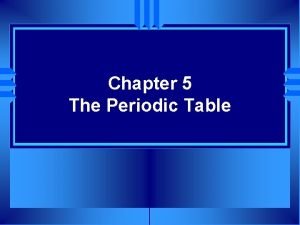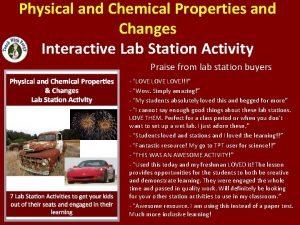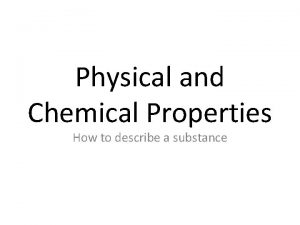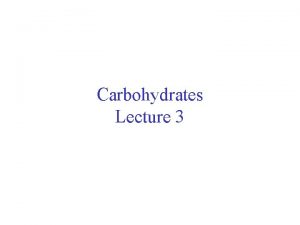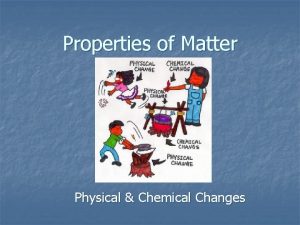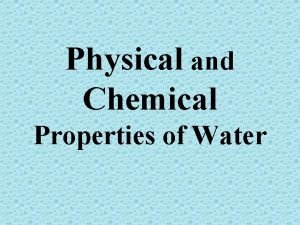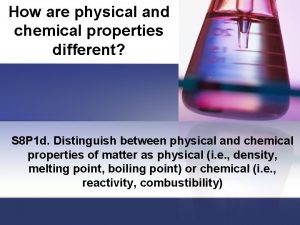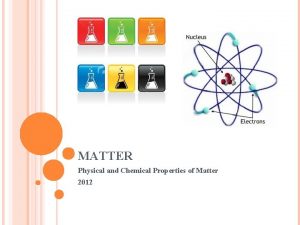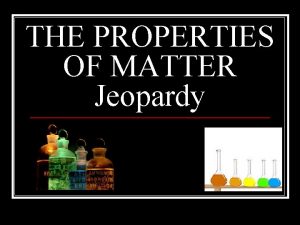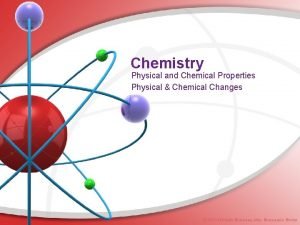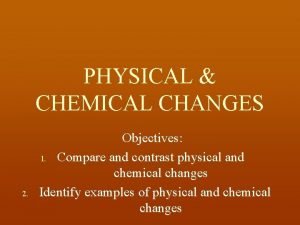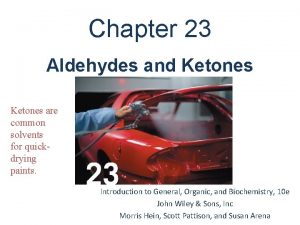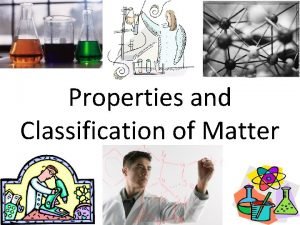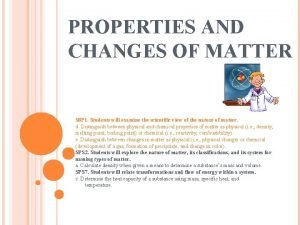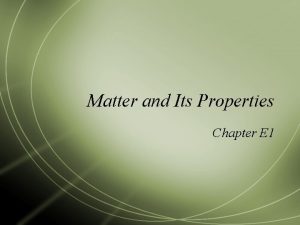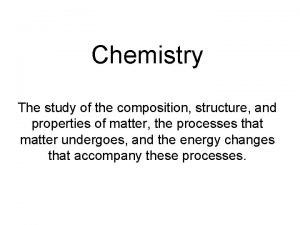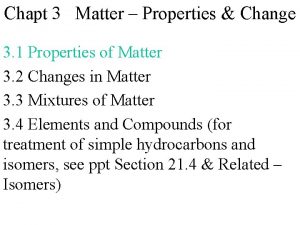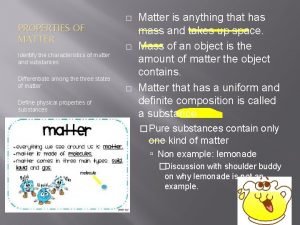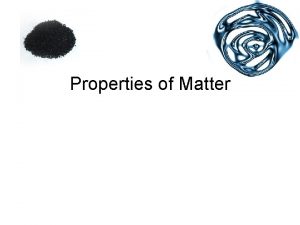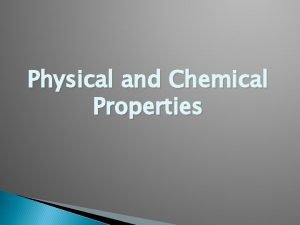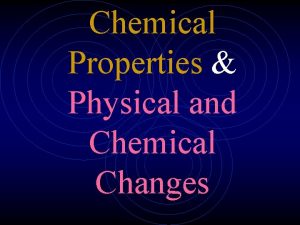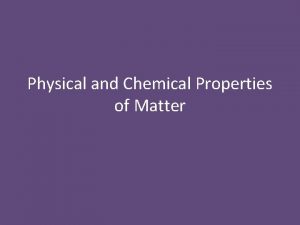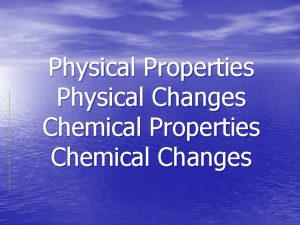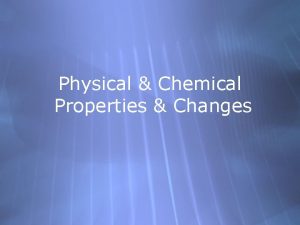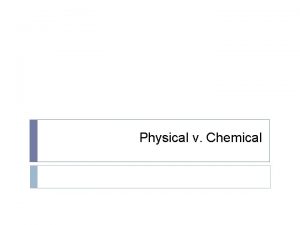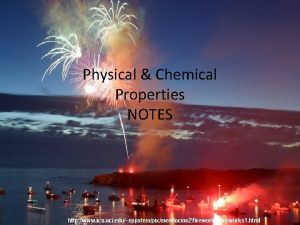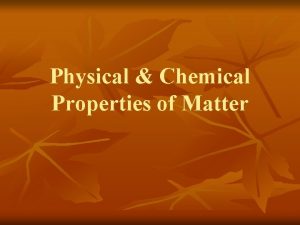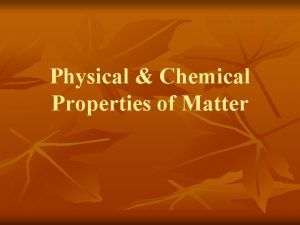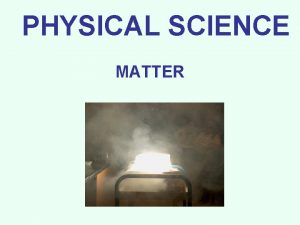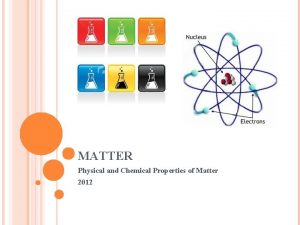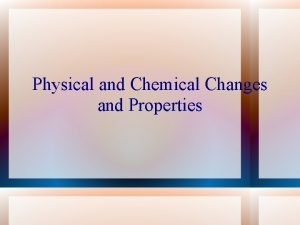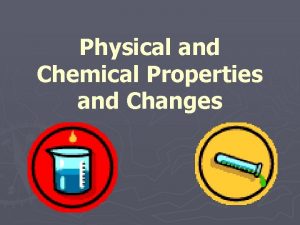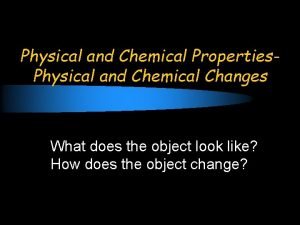MATTER Physical and Chemical Properties of Matter 2012






































- Slides: 38

MATTER Physical and Chemical Properties of Matter 2012

WHAT IS MATTER? Anything that has mass and takes up space (volume). Examples of matter:

LAW OF CONSERVATION OF MATTER CANNOT BE CREATED OR DESTROYED IT JUST CHANGES FROM ONE FORM TO ANOTHER. (MATTER GETS RECYCLED)

THEORY OF KINETIC ENERGY 1. ATOMS ARE ALWAYS MOVING 2. THE MORE ENERGY ADDED TO THE ATOMS, THE FASTER & FARTHER APART THEY MOVE ENERGY ADDED

MATTER Matter can be described by using physical and chemical properties. These are characteristics the matter has that make it unique. Physical Properties: Are properties that can be observed or measured. (color, mass, length, volume, density, state, etc). Physical Properties can be either: Observable or Measurable

OBSERVABLE PHYSICAL PROPERTIES Observable Physical Properties: Properties you can use your senses to get information about an object. If you can describe the matter based on what it looks, feels, smells or tastes like, you are describing the physical properties.

EXAMPLES OF OBSERVABLE PHYSICAL PROPERTIES Malleability: the ability of a substance to be pounded into thin sheets.

EXAMPLES OF OBSERVABLE PHYSICAL PROPERTIES Color: The color of object can be seen and is a physical property of matter. Color can help identify a substance. For example, sulfur is usually yellow in color, iodine is usually red in color. Sulfur Iodine

EXAMPLES OF OBSERVABLE PHYSICAL PROPERTIES Smell: The smell or odor an object gives off can also help identify a substance. For example, sulfur has a rotten egg smell, vinegar has a very acidic smell, and chlorine has a very strong bleach smell.

EXAMPLES OF OBSERVABLE PHYSICAL PROPERTIES Conduction of heat or electricity: The ability for heat and electricity to pass through an object easily. Metals are usually the best conductors of heat and electricity.

EXAMPLES OF OBSERVABLE PHYSICAL PROPERTIES Insulator of electricity or heat: when an object passes heat and electricity poorly. Nonmetals are usually good insulators.

EXAMPLES OF OBSERVABLE PHYSICAL PROPERTIES Ductility: the ability to be drawn or pulled into a wire. Metals usually are ductile.

EXAMPLES OF OBSERVABLE PHYSICAL PROPERTIES Solubility: The ability to dissolve in a nother substance. Examples: sugar dissolves in water.

EXAMPLES OF OBSERVABLE PHYSICAL PROPERTIES State of Matter: Matter can either be a solid, liquid, gas, or plasma. We observe this by using our senses.

STATES OF MATTER State of matter is a physical property!!!! MATTER CAN BE FOUND IN 4 STATES (PHASES) SOLID LIQUID GAS PLASMA http: //www. harcourtschool. com/activity/states_of_matter/

PARTICLES of a SOLID (Physical Property) Pattern: ATOMS (PARTICLES) ARE ARRANGED CLOSELY PACKED TOGETHER Movement: VIBRATE Shape/Volume: HAS FIXED SHAPE & FIXED VOLUME

In Solids, the particles are very tightly packed SO –THE OBJECT IS HARDER – THE MORE DIFFICULT IT IS TO BREAK THEM APART – THE MORE ENERGY NEEDED TO CHANGE FROM A SOLID TO A LIQUID

The particles in a LIQUID: Pattern: none Movement: atoms roll or slide over each other and move faster than a solid. Shape: No fixed shape, takes shape of container Volume: Fixed

The particles in a GAS: Pattern: none Movement: PARTICLES MOVE VERY FAST & AS FAR APART AS THEY CAN GET Shape: NO FIXED SHAPE, takes shape of container Volume: No fixed volume

The particles in PLASMA: Pattern: none Movement: Particles move very fast and are therefore very HOT Shape/Volume: NO FIXED SHAPE OR VOLUME Facts: Most common state of matter in the universe. Most Uncommon state of matter on Earth. Found in lightning, fluorescent lights and stars (Sun)

MEASURABLE PROPERTIES OF MATTER Measurabe Properties: Properties that must be measured with a tool (ruler, beaker, graduated cylinder, scale, etc. ). Ruler Beaker Scale Graduated Cylinder Triple Beam Balance

MEASURABLE PROPERTIES OF MATTER Mass: is the amount of matter that something is made of. Calculate: Using a triple beam balance or a scale. Unit: in science ALWAYS use grams (g) or kilograms (kg).

MEASURABLE PROPERTIES OF MATTER Weight: is the amount gravity is pulling on an object. Different on the MOON!!! Other wise it is measured the same as MASS!!

MEASURABLE PROPERTIES OF MATTER Volume: the amount of space an object takes up. Measured by: different for regular solid, irregular solid and liquids. Examples of Regular Solids: any solid you can measure the length, width and height of. Examples of Irregular Solids: any solid you cannot measure the length, width and height of. Examples of Liquids: any object that has no definite shape but does have a definite volume.

Measurable Properties of Matter Measuring the Volume of Liquids: How to calculate: Use a graduate cylinder to find the volume at the meniscus. Material: graduated cylinder, beaker, flask How to read a graduated cylinder Must be at eye level to read. Must read to bottom of the curve. MENISCUS - bottom of the curve. Unit: m. L or L

MEASURABLE PROPERTIES OF MATTER Measuring Volume of Regular Solids: measure the length, width and height with ruler and multiply them together. Length X Width X Height = Volume of Regular Solid cm X cm = cm 3 *ALWAYS USE CENTIMETERS IN SCIENCE!!!! UNIT: cm 3

MEASURABLE PROPERTIES OF MATTER Measuring Volume of Irregular Solids: Water displacement. Put water into a graduated cylinder and record volume. Place irregular solid into cylinder with water and record second volume. Subtract the two amounts. Initial volume (water only) – volume with irregular solid = volume of solid UNIT: measured in m. L but, since it is a solid use cm 3. 1 m. L = 1 cm 3

MEASURABLE PROPERTIES OF MATTER Density: the amount of matter in a given space or volume. Density is used to describe matter because everything has a different density.

MEASURABLE PROPERTIES OF MATTER Measure by: dividing and objects mass by it’s volume. Calculate: Density = Mass/Volume m D = ------V Mass divided by Volume m D V UNIT: since mass is measured in grams and volume is measured in cm 3 or m. L the unit for density has to have those two units. So, the unit for density is g/m. L or g/cm 3.

BELLRINGER Calculate the density for the following objects: 2 g/ml sinker a. Mass= 10 Volume= 5 2 g/cm sinker b. Mass= 16 Volume= 8 c. Mass= 5 Volume= 10 0. 5 g/ml floater d. Mass= 12 Volume= 12 1 g/cm water 3 3 Which object is water? Which object will float in water? Which objects will sink in water?

DENSITY OF WATER!!!!! The density of water is ALWAYS 1. 0 g/m. L. Anything less than 1. 0 g/m. L will FLOAT. Anything greater than 1. 0 g/m. L will sink.

These are two, unopened full cans of soda. Explain why one is floating and one has sunk.

Why are some objects less dense than other objects? As the molecules of a substance spread apart, the density of the substance is lowered. What causes molecules to spread? Adding energy so the movement of the molecules increases.

Objects float in other substances because they are less dense than the substance they are floating in. Why does ice float in water? They are both the same substance, right?

Notice how tightly packed the atoms are in the liquid water vs the solid water? The spaces between the atoms make solid water less dense. Is this true for all solids? NO WAY!!! This is a unique quality of water. Most solids are always more dense than their liquid forms.

Why does this happen? Hot air balloon rises Atmosphere changes as you climb a mountain Basketball goes flat in winter Perfume can be smelled all over the room

DENSITY When does an objects density change? If heat is added or taken away!!!! HEAT – spreads out molecules – LESS dense Take AWAY heat – molecules come together – MORE dense. Hot objects are less dense than cool objects!!!!

CHEMICAL PROPERTIES OF MATTER Chemical Properties- Properties that determine whether or not a substance will react chemically. Flammability: the ability to burn. Reactivity: The ability for a substance to react with another. Simply, when two substances get together, something can happen.
 Chemical property definition
Chemical property definition Properties of sulphuric acid
Properties of sulphuric acid Ethan is observing chemical and physical properties
Ethan is observing chemical and physical properties Marginal percolation
Marginal percolation Chemical properties
Chemical properties Hardness property of matter
Hardness property of matter Physical properties of oxygen family
Physical properties of oxygen family Physical and chemical properties interactive
Physical and chemical properties interactive Physical and chemical properties of silver
Physical and chemical properties of silver Chemical properties of maltose
Chemical properties of maltose Is dissolving salt in water physical or chemical
Is dissolving salt in water physical or chemical Water chemical and physical properties
Water chemical and physical properties Physical and chemical properties sorting activity
Physical and chemical properties sorting activity True or false: chemical and physical changes alter matter.
True or false: chemical and physical changes alter matter. Is odor observable or measurable
Is odor observable or measurable What are some chemical properties of matter
What are some chemical properties of matter Physical/chemical changes & properties color by number
Physical/chemical changes & properties color by number Physical properties of matter jeopardy
Physical properties of matter jeopardy Graphic organizer matter
Graphic organizer matter Physical properties of matter
Physical properties of matter Compare and contrast chemical and physical changes
Compare and contrast chemical and physical changes Chapter 7 review chemical formulas and chemical compounds
Chapter 7 review chemical formulas and chemical compounds What is the chemical formula for tetranitrogen heptoxide?
What is the chemical formula for tetranitrogen heptoxide? Chemical properties and changes lesson 4
Chemical properties and changes lesson 4 Chemical properties of aldehydes and ketones
Chemical properties of aldehydes and ketones Intensive property and extensive properties
Intensive property and extensive properties Classification and properties of matter
Classification and properties of matter Properties and changes of matter worksheet
Properties and changes of matter worksheet Matter and its properties
Matter and its properties Study of composition structure and properties
Study of composition structure and properties Matter-properties and changes answer key
Matter-properties and changes answer key Properties and characteristics of matter
Properties and characteristics of matter Big idea 9 changes in matter
Big idea 9 changes in matter Useful materials examples
Useful materials examples Matter and materials grade 7
Matter and materials grade 7 White matter nervous system
White matter nervous system Cerebral aqueduct
Cerebral aqueduct Gray matter and white matter
Gray matter and white matter Rhinencephalon
Rhinencephalon

